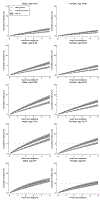Second malignancies in patients with myeloproliferative neoplasms: a population-based cohort study of 9379 patients
- PMID: 29535425
- PMCID: PMC7552081
- DOI: 10.1038/s41375-018-0027-y
Second malignancies in patients with myeloproliferative neoplasms: a population-based cohort study of 9379 patients
Abstract
To determine the risk of a wide range of second malignancies in patients with myeloproliferative neoplasms (MPNs), we conducted a large population-based study and compared the results to matched controls. From national Swedish registers, 9379 patients with MPNs diagnosed between 1973 and 2009, and 35,682 matched controls were identified as well as information on second malignancies, with follow-up until 2010. Hazard ratios (HRs) with 95 % confidence intervals (CIs) were calculated using Cox regression and a flexible parametric model. There was a significantly increased risk of any non-hematologic cancer with HR of 1.6 (95% CI: 1.5-1.7). The HRs for non-melanoma skin cancer was 2.8 (2.4-3.3), kidney cancer 2.8 (2.0-4.0), brain cancer 2.8 (1.9-4.2), endocrine cancers 2.5 (1.6-3.8), malignant melanoma 1.9 (1.4-2.7), pancreas cancer 1.8 (1.2-2.6), lung cancer 1.7 (1.4-2.2), and head and neck cancer 1.7 (1.2-2.6). The HR of second malignancies was similar across all MPN subtypes, sex, and calendar periods of MPN diagnosis. The risk of developing a hematologic malignancy was also significantly increased; the HR for acute myeloid leukemia was 46.0 (32.6-64.9) and for lymphoma 2.6 (2.0-3.3). In conclusion, our study provides robust population-based support of an increased cancer risk in MPN patients.
Conflict of interest statement
Figures




Similar articles
-
Risk for Arterial and Venous Thrombosis in Patients With Myeloproliferative Neoplasms: A Population-Based Cohort Study.Ann Intern Med. 2018 Mar 6;168(5):317-325. doi: 10.7326/M17-0028. Epub 2018 Jan 16. Ann Intern Med. 2018. PMID: 29335713 Free PMC article.
-
Risk and Cause of Death in Patients Diagnosed With Myeloproliferative Neoplasms in Sweden Between 1973 and 2005: A Population-Based Study.J Clin Oncol. 2015 Jul 10;33(20):2288-95. doi: 10.1200/JCO.2014.57.6652. Epub 2015 Jun 1. J Clin Oncol. 2015. PMID: 26033810
-
Mutual Risks of Cutaneous Melanoma and Specific Lymphoid Neoplasms: Second Cancer Occurrence and Survival.J Natl Cancer Inst. 2018 Nov 1;110(11):1248-1258. doi: 10.1093/jnci/djy052. J Natl Cancer Inst. 2018. PMID: 29659938 Free PMC article.
-
Characteristics of patients with myeloproliferative neoplasms with lymphoma, with or without JAK inhibitor therapy.Blood. 2019 May 23;133(21):2348-2351. doi: 10.1182/blood-2019-01-897637. Epub 2019 Feb 22. Blood. 2019. PMID: 30796023 Free PMC article. Review.
-
Therapy-associated leukemic transformation in myeloproliferative neoplasms - What do we know?Best Pract Res Clin Haematol. 2019 Mar;32(1):65-73. doi: 10.1016/j.beha.2019.02.004. Epub 2019 Feb 8. Best Pract Res Clin Haematol. 2019. PMID: 30927977 Review.
Cited by
-
Topics of Interest in Women With Myeloproliferative Neoplasms.Am J Hematol. 2025 Jun;100 Suppl 4(Suppl 4):74-87. doi: 10.1002/ajh.27665. Epub 2025 Mar 14. Am J Hematol. 2025. PMID: 40084464 Free PMC article. Review.
-
Emerging trends in the coexistence of primary lung Cancer and hematologic malignancy: a comprehensive analysis of clinicopathological features and genetic abnormalities.Cancer Cell Int. 2024 Feb 24;24(1):84. doi: 10.1186/s12935-024-03264-x. Cancer Cell Int. 2024. PMID: 38402182 Free PMC article.
-
Defying the Odds: Small Cell Lung Cancer with Essential Thrombocythemia and Secondary Cancers.Cureus. 2025 Jun 15;17(6):e86093. doi: 10.7759/cureus.86093. eCollection 2025 Jun. Cureus. 2025. PMID: 40672006 Free PMC article.
-
Inflammatory Microenvironment and Specific T Cells in Myeloproliferative Neoplasms: Immunopathogenesis and Novel Immunotherapies.Int J Mol Sci. 2021 Feb 14;22(4):1906. doi: 10.3390/ijms22041906. Int J Mol Sci. 2021. PMID: 33672997 Free PMC article. Review.
-
Caution in using second generation tyrosine kinase inhibitor, especially for first line therapy of chronic myeloid leukemia.Am J Hematol. 2022 Aug;97(8):E296-E298. doi: 10.1002/ajh.26618. Epub 2022 Jun 9. Am J Hematol. 2022. PMID: 35604243 Free PMC article. No abstract available.
References
-
- Swerdlow SH, International Agency for Research on Cancer., World Health Organization. WHO classification of tumours of haematopoietic and lymphoid tissues. Lyon, France: International Agency for Research on Cancer; 2008. 439 p. p.
-
- Barbui T, Barosi G, Birgegard G, Cervantes F, Finazzi G, Griesshammer M, et al. Philadelphia-negative classical myeloproliferative neoplasms: critical concepts and management recommendations from European LeukemiaNet. Journal of clinical oncology : official journal of the American Society of Clinical Oncology. 2011;29(6):761–70. - PMC - PubMed
-
- Hultcrantz M, Kristinsson SY, Andersson TM, Landgren O, Eloranta S, Derolf AR, et al. Patterns of survival among patients with myeloproliferative neoplasms diagnosed in Sweden from 1973 to 2008: a population-based study. Journal of clinical oncology : official journal of the American Society of Clinical Oncology. 2012;30(24):2995–3001. - PMC - PubMed
-
- Barbui T, Thiele J, Passamonti F, Rumi E, Boveri E, Ruggeri M, et al. Survival and disease progression in essential thrombocythemia are significantly influenced by accurate morphologic diagnosis: an international study. Journal of clinical oncology : official journal of the American Society of Clinical Oncology. 2011;29(23):3179–84. - PubMed
MeSH terms
Grants and funding
LinkOut - more resources
Full Text Sources
Other Literature Sources

